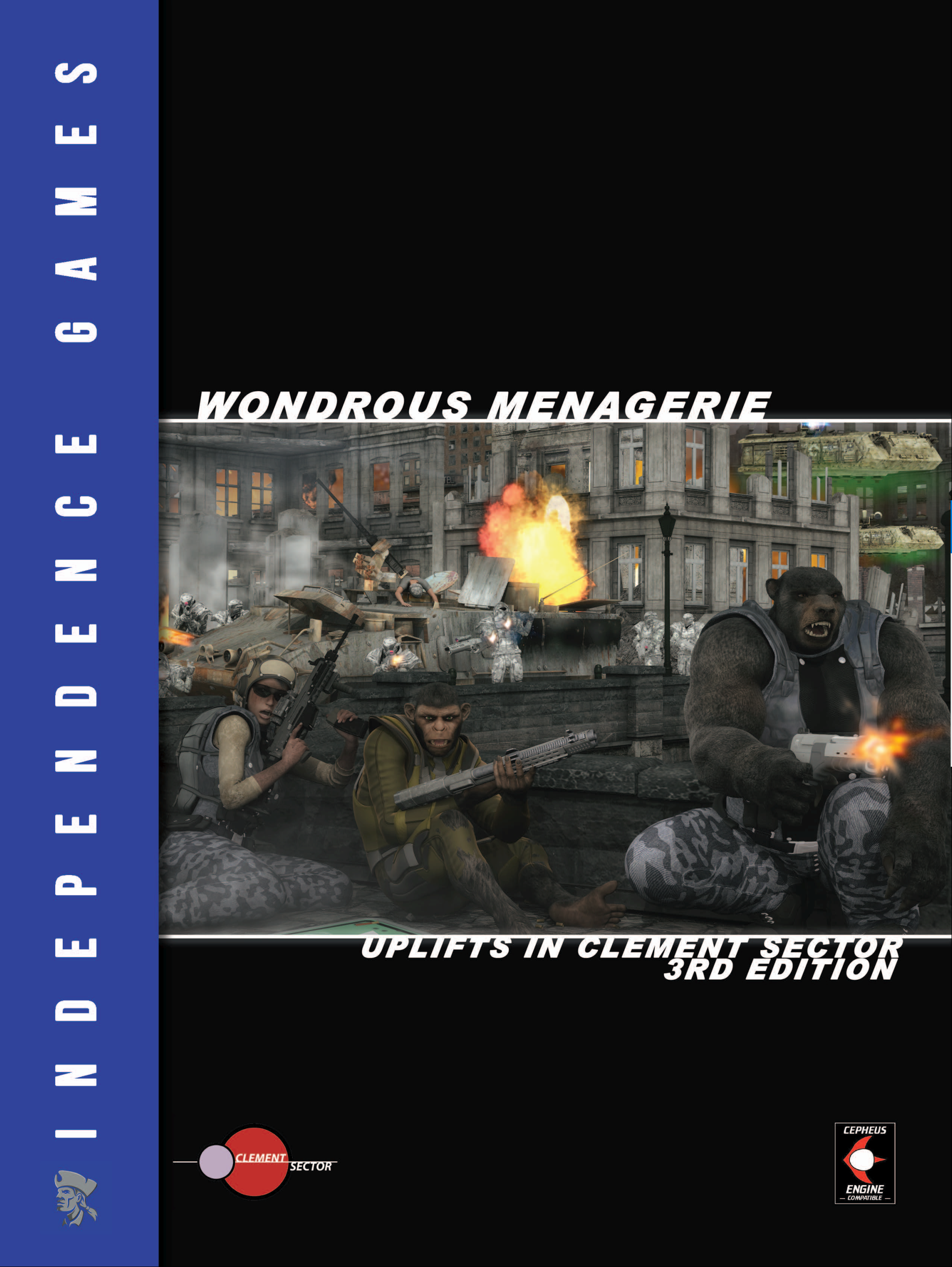Wondrous Menagerie
This article originally appeared in the May/June 2023 issue.
 Wondrous Mengagerie. John Watts.
Wondrous Mengagerie. John Watts.
Independence Games https://independencerpgs.com
84pp., PDF, Softcover, Hardbound
US$34.99(H+P), $24.99(S+P), $9.99(P)
UK£28.49(H+P), £20.35(S+P), £8.13(P)
Animals raised up to human levels of intelligence is a common trope in SF, and Traveller and its relatives aren’t exempt. Wondrous Menagerie, although written for Independence Games’ Clement Sector setting, can be used for inspiration for the role and status of uplifts in any setting.
(Even if you want to adapt the material presented in Wondrous Menagerie to a non-Clement Sector setting, having the Clement Sector core volume as a companion to this should be considered mandatory, as character generation for uplifts is presented as modifications from the standard Clement Sector character generation sequence.)
This volume opens with discussion of what an “uplift” is – an animal that has been given human-equivalent capabilities – and describes the wide range of opinion about uplifts that can be found in Clement Sector. Discrimination aside, not all uplifts are created equal, and three classes – it might be better to say ‘types’, as ‘class’ tends to imply a social hierarchy – of uplifts are mentioned, and two defined:
Class 1 uplifts do not vary greatly in body from the ‘baseline’ animal that they are uplifted from; the augmentations are generally limited to mindcomps to enhance their intelligence, memory, and ability to communicate, generally via a voder, but occasionally through modifications of the vocal apparatus. Also included in Class 1 are animals that are not augmented to human levels, but are enhanced and modified to perform specific tasks. Individual common uplifted animals are described, along with modifications to basic characteristics from character generation. Most Class 1 uplifts cannot pass their ‘uplifted’ status to offspring; the changes are not genetic.
Class 2 uplifts tend to be farther from the baseline animal; they are modified to be closer to the human baseline (e.g., having hands, rather than paws; walking upright rather than quadrupedally, etc.), while retaining (or in some cases, gaining) characteristics that are advantageous to the uplifted animal (e.g., strength for great apes and bears). Many, but not all, of the changes made to Class 2 uplifts are genetic, and will breed true.
(Class 3 uplifts are suggested as being for bringing animals that are farther from the human baseline into the same degree of conformity with the human model as current Class 2 uplifts. The ‘Kraken’ uplift is suggested as being the first of the Class 3s.)
All uplifts have modified character generation for characteristics and aging. The status of an uplift in Clement Sector can range from outright slave (there is a separate career for uplift slaves in this volume) through segregation (either with uplifts of the character’s same type in a homogeneous segregated community, or with other uplift types in a mixed-species segregated community), to a free citizen. Uplifts other than free citizens roll their youth and teenage Events from tables in this book; free citizens apply the characteristic and aging modifiers from this book, but otherwise follow the standard character generation from the Clement Sector core book (or your preferred setting that you want to ‘graft’ uplifts into).
Within the Clement Sector setting, uplifts have their own naming practices that tend not to follow human conventions, though many names may be sourced from human cultures. A selection of ‘typical’ names is provided for some species. Feel free, obviously, to follow or ignore this as you choose for your own preferred setting.
A few political organizations relevant to uplifts and their status in the Clement Sector setting are provided; these can be used to inspire other organizations in your own setting.
Two new skills specific to settings with uplifts are described; I would treat the “Language (Ape)” skill as inspiration for others, and allow most other uplifts a species-specific “language”. In the Clement Sector setting, Language (Ape) is described as a way of communicating emotion, rather than being on a par with human languages. Obviously, you have the discretion to retain this limitation, or allow it to be a “full-fledged” language, like the various national Sign languages are for the hearing-impaired today. The other skill, “Science (Uplift Psychology)” suggests, reasonably, that uplifts may face psychological issues that other sophonts might not. Arguably, an uplift that still requires e.g., mindcomps or other assistive technology might (also) have issues similar to a human needing assistive technology, so if you want to keep this skill in your variant setting, consider whether you want to limit it to specific issues that uplifts face that humans won’t (e.g., animal instincts vs. human cultural mores), or make it applicable to uplifts even in those areas where uplifts and humans face the same challenges.
Overall, I think this is worth the coin for any referee that wants inspiration for using uplifts in any setting; as uplifts are a definite part of the Clement Sector setting, I’d consider this essential for the Clement Sector referee.
 Freelance
Traveller
Freelance
Traveller